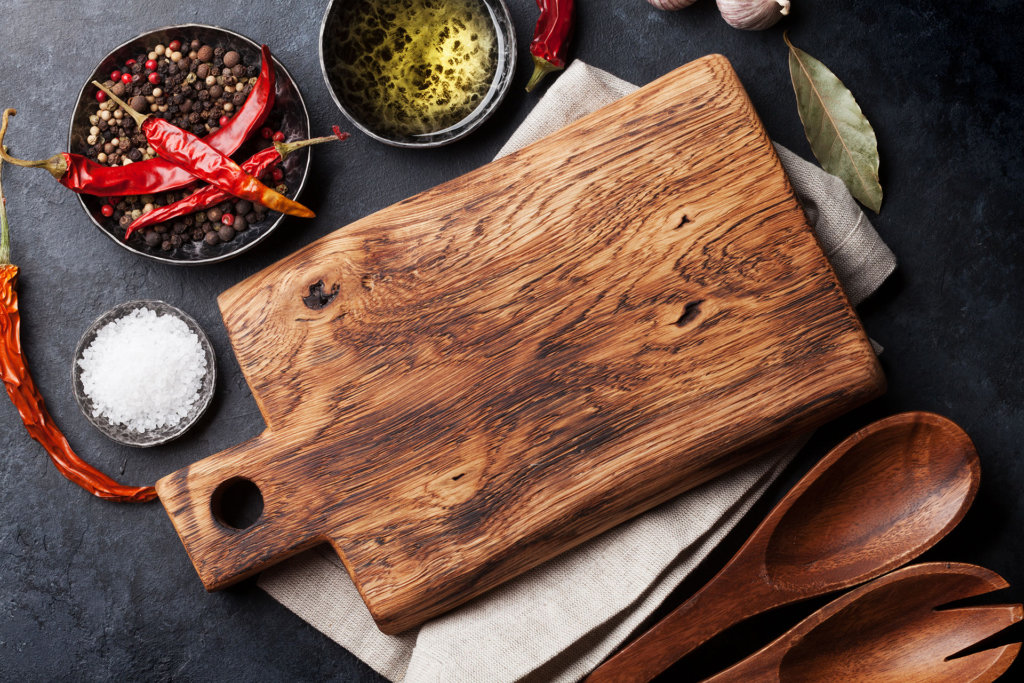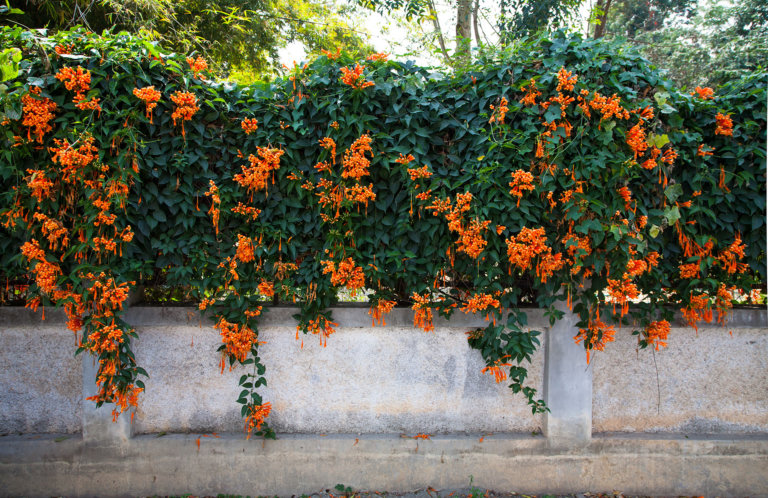Cutting boards are versatile kitchen accessories used for food prep and serving. Due to constant contact with food and knives, it’s important to choose a board that offers a durable, sanitary surface.
Many people focus on the dimensions and appearance of the cutting boards. However, the quality of the board depends heavily on the type of wood. Some wood is more prone to moisture, stains, and damage, making them unusable after a few meals.
To get more use out of your next cutting board, try to find an option made from one of the following best types of wood.
#1: Maple
Maple is the most popular choice of wood for a cutting board due to its hardness. Maple ranks higher on the Janka hardness scale, which is used to rate the hardness of the wood.
Hardwood maple is more scratch-resistant compared to other common types of wood, such as beech and teak. However, it is not hard enough to increase the risk of dulling your knives.
Another benefit of maple is the size of the pores. With smaller pores, the wood absorbs less moisture, making it more sanitary.
Maple stands out as the top choice for cutting boards but also has a few drawbacks. The off-white or amber surface stains easily. The board is also more prone to shrinkage compared to other woods and requires frequent conditioning to keep it from entirely drying out.
#2: Beech
Beech offers many of the advantages provided by maple. It is a hardwood with small pores, helping to reduce the risk of bacteria and moisture. Compared to softer wood, beech is also less likely to crack or warp.
These cutting boards require more maintenance compared to cheaper woods. As with maple cutting boards, beech cutting boards can shrink when they dry out. To protect the board, you need to apply oil at least once per month.
Beech boards are often cream or light brown. The lighter color shows stains more easily and requires additional cleaning to maintain a clean look.
Despite a few drawbacks, beech is still a top choice for cutting boards thanks to its durability, especially when purchasing an edge-grain or end-grain board. It also tends to cost a little less compared to maple.
#3: Teak
Teak is an interesting choice of wood for a cutting board due to its limited availability. It is endangered in some regions, which drives up the cost of teak cutting boards. It also has a high silica content, potentially increasing the risk of dulling your knife blades.
Teak is slightly softer compared to maple and beech but harder than walnut. It also has large pores that can hold moisture, requiring frequent cleaning to prevent bacteria growth.
While teak has several disadvantages, it is more affordable in terms of maintenance compared to other hardwoods. The darker hue of the wood also helps mask stains while the larger pores reduce the need for conditioning. These features make it easier to maintain a teak cutting board.
#4: Cherry
Cherry is often overlooked as a quality wood for cutting boards. However, it has several useful features, including a darker color that helps hide stains.
Cherry is a closed-grain hardwood, similar to maple and beech. It offers greater protection against knife marks without dulling the knives. The smaller pores also protect against mildew and bacteria, making it easy to care for.
As with the other closed-grain hardwoods, cherry requires conditioning to keep it from drying out. You typically need to apply oil once or twice per month.
The wood tends to darken over time, which may not provide the aesthetics that you want in your kitchen. It is also one of the most expensive choices, typically costing more than maple or beech.
#5: Acacia
Acacia is quickly becoming a top-selling choice for cutting boards and other wood products. It offers a cheaper alternative compared to many of the costly hardwoods such as maple and beech.
Along with a lower price, acacia wood contains natural oils that increase the moisture resistance of the boards. The natural oils also reduce the risk of warping and cracking from dryness.
Acacia boards are surprisingly durable for their price point. The wood is harvested at a younger age, resulting in smaller planks.
With smaller planks, manufacturers find it easier to use end-grain construction, which increases the durability of the board. The end-grain construction also creates a checkered pattern that many home chefs find appealing.
#6: Walnut
Walnut is softer than the previous choices but still hard enough to protect against sharp knives. It holds up well without dulling knife blades and requires less conditioning to prevent dryness.
Walnut has slightly larger pores compared to maple and beech but smaller than teak. It is still a food-safe option and partially resistant to bacteria and moisture.
Many people also like the appearance of walnut. It is available in rich, dark hues that help decrease the appearance of stains.
You can expect to pay more for a walnut cutting board with options ranging from $20 to $200 or more. However, walnut cutting boards also tend to last longer. Overall, walnut requires less maintenance than other hardwoods and is less likely to dull your knives.
#7: Bamboo
Bamboo is technically not wood. It is a grass that grows incredibly fast, producing thick shoots that can be used as an affordable and sustainable alternative to wood. Due to the abundance of bamboo, it is a cheap material. However, it does have a few benefits.
Bamboo cutting boards are relatively durable. Bamboo is virtually maintenance-free and may last longer compared to other woods.
The material is incredibly dense, keeping it from absorbing water and helping to prevent warping and cracking. It is also less likely to show marks from knives.
The density of the wood makes the board more durable but also dulls blades quickly. If you use a bamboo cutting board, you may need to sharpen your knives a little more frequently.
Types of Wood Grain
Along with the type of wood, you should consider the type of wood grain. The three main grains include face, edge, and end.
Face Grain
Face grain is what you see on the outside of most boards and lumber. It showcases the unique pattern of the grain, making it a popular choice for everything from cutting boards to tabletops and hardwood flooring.
While face-grain cutting boards are often the most attractive as they show more of the grain, they are the least durable choice. The face grain quickly shows knife marks, making it unsuitable for heavy chopping.
Face-grain boards made from inferior woods are also likely to become damaged quickly. They are made from thinner sheets of wood glued together, making it easier for the board to warp or crack. However, they are the most affordable choice.
Edge Grain
Edge grain is found on the side of a piece of lumber. Cutting boards with edge grain are made by gluing the faces of multiple strips of wood together, exposing edges of the strips.
Edge-grain cutting boards showcase less of the grain compared to face-grain boards, which may make them less visually appealing. However, this design also prevents the board from soaking up moisture, protecting against mold growth.
These boards are also less likely to show knife marks compared to face-grain boards. They are durable, moisture-resistant, and a good middle ground between face-gain boards and end-grain boards.
End Grain
End grain is what you see on the ends of pieces of wood. With an end-grain cutting board, multiple pieces of wood are cut into blocks and glued together with the ends facing up.
When you look at the end of a piece of wood, the end grain is often rough. This provides several distinct benefits for cutting boards. The rough pattern helps prevent knife marks and limits damage to knives and cutting utensils. It also helps make the boards more durable.
The main drawback to an end-grain cutting board is the price. As end grain is more difficult to work with, these boards can cost significantly more compared to face-grain or edge-grain options.
Summary
The type of wood and grain are the main two features when comparing cutting boards. Maple is the top choice due to its durability. It is a hardwood with small pores, which reduces the risk of bacterial growth, warping, and cracking. Beech and walnut are close behind but may cost a little more.
Acacia and bamboo are two of the most affordable options. They are also durable choices but may dull your knives.
Frequently Asked Questions
What kinds of wood should you not use for a cutting board?
Avoid using softwoods such as cedar or pine. Softwoods are more likely to become damaged from sharp blades and may also dull your knives.
Is oak good for cutting boards?
While oak is a hardwood, it also has large pores. The larger pores allow more moisture to soak into the board, increasing the risk of bacterial growth and mold. If you choose an oak cutting board, look for designs that feature the edge grain as the edges soak up less moisture.
How thick should a cutting board be?
Cutting boards vary in thickness from 0.5 inches to 2.5 inches. Butchers typically use butcher blocks that are least 1.5 inches thick. For general use in a home kitchen, you may want a board that is at least one inch thick.







